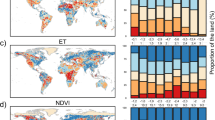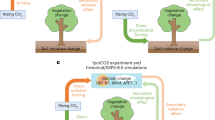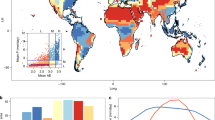Abstract
Floods and droughts cause perhaps the most human suffering of all climate-related events; a major goal is to understand how humans alter the incidence and severity of these events by changing the terrestrial water cycle. Here we use over 1,500 estimates of annual evapotranspiration and a database of global land-cover change1 to project alterations of global scale terrestrial evapotranspiration (TET) from current anthropogenic land-cover change. Geographic modelling reveals that land-cover change reduces annual TET by approximately 3,500 km3 yr−1 (5%) and that the largest changes in evapotranspiration are associated with wetlands and reservoirs. Land surface model simulations support these evapotranspiration changes, and project increased runoff (7.6%) as a result of land-cover changes. Next we create a synthesis of the major anthropogenic impacts on annual runoff and find that the net result is an increase in annual runoff, although this is uncertain. The results demonstrate that land-cover change alters annual global runoff to a similar or greater extent than other major drivers, affirming the important role of land-cover change in the Earth System2,3,4. Last, we identify which major anthropogenic drivers to runoff change have a mean global change statistic that masks large regional increases and decreases: land-cover change, changes in meteorological forcing, and direct CO2 effects on plants.
This is a preview of subscription content, access via your institution
Access options
Subscribe to this journal
Receive 12 print issues and online access
$209.00 per year
only $17.42 per issue
Buy this article
- Purchase on Springer Link
- Instant access to full article PDF
Prices may be subject to local taxes which are calculated during checkout



Similar content being viewed by others
References
Sterling, S. & Ducharne, A. Comprehensive data set of global land cover change for land surface model applications. Glob. Biogeochem. Cycles 22, GB3017 (2008).
Pielke, R. A. et al. Land use/land cover changes and climate: Modeling analysis and observational evidence. Wires Climatic Change 2, 828–850 (2011).
NRC, Radiative Forcing of Climate Change: Expanding the Concept and Addressing Uncertainties (National Research Council, 2005).
Ban-Weiss, G. A., Bala, G., Cao, L., Pongratz, J. & Caldeira, K. Climate forcing and response to idealized changes in surface latent and sensible heat. Environ. Res. Lett. 6, 034032 (2011).
Erb, K. H. et al. Analyzing the global human appropriation of net primary production—processes, trajectories, implications. Ecol. Econ. 69, 250–259 (2009).
Postel, S. L., Daily, G. C. & Ehrlich, P. R. Human appropriation of renewable fresh water. Science 271, 785–788 (1996).
Bounoua, L., DeFries, R. S., Collatz, G. J., Sellers, P. & Khan, H. Effects of land cover conversion on surface climate. Climatic Change 52, 29–64 (2002).
Zhao, M., Pitman, A. J. & Chase, T. N. The impact of land cover change on the atmospheric circulation. Clim. Dynam. 17, 467–477 (2001).
Betts, R. A. Biogeophysical impacts of land use on present-day climate: Near surface temperature change and radiative forcing. Atmos. Sci. Lett. 2, 39–51 (2001).
Piao, S. L. et al. Changes in climate and land use have a larger direct impact than rising CO2 on global river runoff trends. Proc. Natl Acad. Sci. USA 104, 15242–15247 (2007).
Findell, K. L., Shevliakova, E., Milly, P. C. D. & Stouffer, R. J. Modeled impact of anthropogenic land cover change on climate. J. Clim. 20, 3621–3634 (2007).
Gordon, L. J. et al. Human modification of global water vapor flows from the land surface. Proc. Natl Acad. Sci. USA 102, 7612–7617 (2005).
Gedney, N. et al. Detection of a direct carbon dioxide effect in continental river runoff records. Nature 439, 835–838 (2006).
Rost, S., Gerten, D. & Heyder, U. Human alterations of the terrestrial water cycle through land management. Adv. Geosci. 18, 43–50 (2008).
Gerten, D., Schaphoff, S., Haberlandt, U., Lucht, W. & Sitch, S. Terrestrial vegetation and water balance—hydrological evaluation of a dynamic global vegetation model. J. Hydrol. 286, 249–270 (2004).
Haberl, H. et al. Quantifying and mapping the human appropriation of net primary production in earth’s terrestrial ecosystems. Proc. Natl Acad. Sci. USA 104, 12942–12945 (2007).
Haddeland, I., Skaugen, T. & Lettenmaier, D. P. Hydrologic effects of land and water management in North America and Asia: 1700–1992. Hydrol. Earth Syst. Sci. 11, 1035–1045 (2007).
Vorosmarty, C. J., Green, P., Salisbury, J. & Lammers, R. B. Global water resources: Vulnerability from climate change and population growth. Science 289, 284–288 (2000).
Koster, R. D. et al. Regions of strong coupling between soil moisture and precipitation. Science 305, 1138–1140 (2004).
Zhang, J. Y., Wang, W. C. & Wei, J. F. Assessing land–atmosphere coupling using soil moisture from the Global Land Data Assimilation System and observational precipitation. J. Geophys. Res. 113, D17119 (2008).
Davin, E. L. & de Noblet-Ducoudre, N. Climatic impact of global-scale deforestation: Radiative versus nonradiative processes. J. Clim. 23, 97–112 (2010).
Davin, E. L., de Noblet-Ducoudre, N. & Friedlingstein, P. Impact of land cover change on surface climate: Relevance of the radiative forcing concept. Geophys. Res. Lett. 34, L13702 (2007).
Milliman, J. D., Farnsworth, K. L., Jones, P. D., Xu, K. H. & Smith, L. C. Climatic and anthropogenic factors affecting river discharge to the global ocean, 1951–2000. Glob. Planet Change 62, 187–194 (2008).
Labat, D., Godderis, Y., Probst, J. L. & Guyot, J. L. Evidence for global runoff increase related to climate warming. Adv. Water Resour. 27, 631–642 (2004).
Kundzewicz, Z. W. et al. The implications of projected climate change for freshwater resources and their management. Hydrol. Sci. J. 53, 3–10 (2008).
Milly, P. C. D., Dunne, K. A. & Vecchia, A. V. Global pattern of trends in streamflow and water availability in a changing climate. Nature 438, 347–350 (2005).
Pitman, A. J. et al. Uncertainties in climate responses to past land cover change: First results from the LUCID intercomparison study. Geophys. Res. Lett. 36, L14814 (2009).
Krinner, G. et al. A dynamic global vegetation model for studies of the coupled atmosphere-biosphere system. Glob. Biogeochem. Cycles 19, GB1015 (2005).
Ngo-Duc, T., Polcher, J. & Laval, K. A 53-year forcing data set for land surface models. J. Geophys. Res. 110, D06116 (2005).
De Rosnay, P., Polcher, J., Laval, K. & Sabre, M. Integrated parameterization of irrigation in the land surface model ORCHIDEE, Validation over Indian Peninsula. Geophys. Res. Lett. 30, 1986 (2003).
Ngo-Duc, T., Laval, K., Polcher, J., Lombard, A. & Cazenave, A. Effects of land water storage on global mean sea level over the past half century. Geophys. Res. Lett. 32, L09704 (2005).
Sellers, P. J. et al. A revised land surface parameterization (SiB2) for atmospheric GCMS. Part I: Model formulation. J. Clim. 9, 676–705 (1996).
Sellers, P. J. et al. A revised land surface parameterization (SiB2) for atmospheric GCMS. Part II: The generation of global fields of terrestrial biophysical parameters from satellite data. J. Clim. 9, 706–737 (1996).
Jin, M. & Shepherd, J. M. Inclusion of urban landscape in a climate model: How can satellite data help? Bull. Am. Meteorol. Soc. 86, 681–689 (2005).
Arnfield, A. J. Two decades of urban climate research: A review of turbulence, exchanges of energy and water, and the urban heat island. Int. J. Clim. 23, 1–26 (2003).
Zhang, X., Friedl, M. A., Schaaf, C. B. & Strahler, A. H. Climate controls on vegetation phenological patterns in northern mid- and high latitudes inferred from MODIS data. Glob. Change Biol. 10 (2004).
Jackson, R. B., Mooney, H. A. & Schulze, E. D. A global budget for fine root biomass, surface area, and nutrient contents. Proc. Natl Acad. Sci. USA 94, 7362–7366 (1997).
Oguntoyinbo, J. S. Reflection coefficient of natural vegetation, crops and urban surfaces in Nigeria. Quart. J. R. Meteorol. Soc. 96, 430–441 (1970).
Miranda, A. C. et al. Fluxes of carbon, water and energy over Brazilian cerrado: An analysis using eddy covariance and stable isotopes. Plant. Cell Environ. 20, 315–328 (1997).
Acknowledgements
We gratefully acknowledge the generous contributions of ET data from scientists around the world. We thank T. Ngo Duc, H. Oumer, S. Rojstaczer, W. Schlesinger, R. Jackson and M. Meybeck for helpful comments on an earlier version of this manuscript. We thank M. Mancip and L. Bozec for technical support with the database and LSM simulations. This work was supported by the a Chateaubriand Fellowship for Scientific Research from the Office for Science and Technology of the Embassy of France in the USA, a Marie Curie Intra European Fellowship (#09949), and a Discovery Grant from the National Sciences and Engineering Research Council of Canada (RGPIN/387243-2011).
Author information
Authors and Affiliations
Contributions
S.M.S. designed the research, conducted the data analysis, and wrote the manuscript. The concepts of the land surface modelling were jointly developed and discussed by S.M.S., A.D. and J.P. A.D. assisted with the LSM data analysis. A.D. and J.P. contributed to the conception and analysis of the LSM simulation and to the paper writing. All authors gave comments on the manuscript.
Corresponding author
Ethics declarations
Competing interests
The authors declare no competing financial interests.
Supplementary information
Supplementary Information
Supplementary Information (PDF 1534 kb)
Rights and permissions
About this article
Cite this article
Sterling, S., Ducharne, A. & Polcher, J. The impact of global land-cover change on the terrestrial water cycle. Nature Clim Change 3, 385–390 (2013). https://doi.org/10.1038/nclimate1690
Received:
Accepted:
Published:
Issue Date:
DOI: https://doi.org/10.1038/nclimate1690
This article is cited by
-
Land cover change and its response to water level around Tonle Sap Lake in 1988–2020
Journal of Geographical Sciences (2024)
-
Response of stream water quality to the vegetation patterns on arid slope: a case study of Huangshui River basin
Environmental Science and Pollution Research (2024)
-
Notable shifts beyond pre-industrial streamflow and soil moisture conditions transgress the planetary boundary for freshwater change
Nature Water (2024)
-
Evapotranspiration on a greening Earth
Nature Reviews Earth & Environment (2023)
-
Projected increase in global runoff dominated by land surface changes
Nature Climate Change (2023)



